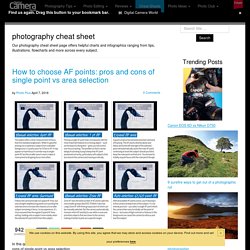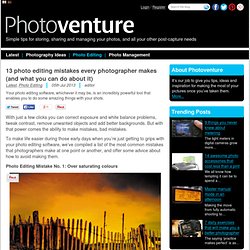

HDR Tutorial – High Dynamic Range Photography Tutorial. Divine Composition With Fibonacci's Ratio (The Rule of Thirds on Steroids) Are you a stickler for little details?

Well, if you’re a photographer, you had better be. Discovering the rule of thirds is a big milestone for any photographer. Suddenly, you realize that all you ever did before was center your subject right smack dab in the middle of the frame, because that’s where the camera’s focus grid is located. Makes sense right? The rule of thirds took you to new heights in your photographic journey, moving your subject off to one side or another in your frame, or to the top or bottom. Enter Fibonacci’s Ratio… Also known as the Golden Mean, Phi, or Divine Proportion, this law was made famous by Leonardo Fibonacci around 1200 A.D. Since the Renaissance, artists and architects have designed their work to approximate this ratio of 1:1.618.
The Rule of Thirds in Real Life: 21 Perfectly-Composed Photos. It’s a popular saying: “Rules are made to be broken.”

But this is only half true, and something that beginners in photography should be wary of. Yes, rules are meant to be broken occasionally… but first you have to know those rules inside out, backwards, and diagonally. In photography, no rules are more common than the Rule of Thirds and the Golden Mean. How to Clean Your Camera Sensor in 3 Easy Steps. A Post By: Alex Morrison There is really nothing more frustrating for photographers than a camera sensor that is full of dust and specks.

Dust on the sensor happens, it’s just a fact of digital photographic life. If you’re an outdoor photographer with a zoom lens, or one who changes lenses in the field, dust and particles will find a way onto your sensor on an almost regular basis. But even studio photographers experience the distress of a dirty sensor. The world’s dirtiest camera sensor.
A few weeks ago I was on a mountain photo tour, and was constantly changing lenses in the windy and dusty alpine weather. Most Popular Gear Articles of 2014. Who owns a photo once it's put online: free cheat sheet to understanding copyright. Who actually owns a photo once you upload it to the internet?

This fantastic photography cheat sheet compiled by Clifton Cameras answers some of the key questions about copyright for photographers. From cases like David Slater’s famed monkey self-portrait to social media ownership to how to protect your photos online, this handy infographic should set you on the right path. Click on the infographic to see the larger version The 55 best photographers of all time. In the history of the world. Photography cheat sheet - Digital Camera World. In this quick tutorial we’ll show you how to choose the right AF points and weigh the pros and cons of single point vs area selection.

10 rules of photo composition (and why they work) In photography, it’s not just what you shoot that counts – the way that you shoot it is crucial, too.

Poor photo composition can make a fantastic subject dull, but a well-set scene can create a wonderful image from the most ordinary of situations. 13 photo editing mistakes every photographer makes (and how to stop!) With just a few clicks you can correct exposure and white balance problems, tweak contrast, remove unwanted objects and add better backgrounds.

But with that power comes the ability to make mistakes, bad mistakes. To make life easier during those early days when you’re just getting to grips with your photo editing software, we’ve compiled a list of the most common mistakes that photographers make at one point or another, and offer some advice about how to avoid making them. Photo Editing Mistake No. 1: Over saturating colours Many images benefit from a little boost to the saturation to bring colours to life, but go easy, and don’t keep pushing it further and further up. How to resize photos for web or email: a simple guide. What’s the best way to resize photos for web use, email or on-screen viewing?

In our quick guide we show you the best method to follow. Current cameras deliver much higher resolution images than you need for sending as email attachments or for posting online. Reducing the physical size and increasing the compression ratio of JPEGs results in files with much smaller data sizes. All good photo-editing programs have tools for doing this, while retaining decent image quality. For on-screen viewing, it’s best to find out the native resolution of the computer monitor, TV, tablet, mobile phone or other device on which you want to display the photos. The aspect ratio will probably be different to that of your camera, so you may also need to crop the images to fill the screen and avoid black bars at the edges. 1 Reduce the size In Photoshop Elements’ Image Size window, enter a new width or height in Pixel Dimensions. 2 Compression Choose a moderate JPEG compression setting.
6 Easy DIY Photography Projects That Make for Great Holiday Gifts. Want to make a photography gift this holiday season instead of buying one?

The video above offers 6 fun ideas for easy DIY photo gifts you can try your hand at. Each product is a different way to share your photography with someone. The video was created by COOPH, the Cooperative of Photography, and features the following ideas: Is Formal Photography Training Necessary? I’ve been actively teaching the Martial Arts for over 30 years.

I was formally trained by an instructor who was formally trained by his instructor who, well you guessed it, was formally trained by his instructor.